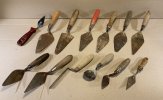B
Billyliar
Guest
May I suggest just mixing it in the wheelbarrow and not using the wheelie bin,
Follow along with the video below to see how to install our site as a web app on your home screen.
Note: This feature may not be available in some browsers.
Precisely! have you felt the weight of a bag of cement!?Rainwater has managed to ingress into the bin, and prodding the bags it feels like the cement has set in them. Even if I could get them out how would I get rid of them? So i'm stuck with an unusable green wheelie bin.

After the giant spider incident the last time I took stuff to the council tip - Nothing from the garden can now ever go in the car because of the risk of creepy crawlies setting up home in the car.
British spiders can't hurt you, the vast majority of the spidery little bitey things can't even break through human or animal skin. False widow spiders are altogether different and can cause chest pain and nausea, and which is not helpful at all if you already have underlying cardiac or other health issues.
These though are tiny and so not the giant spider you had issues with.
House spiders on the whole are useful because they check the spread of insect born diseases in the home and are also considered a lucky charm in many cultures less squeamish than the British.
"If you want to live and thrive, let the spider run alive.”
Hey guyz I thought I give you all some general trowel advice and I bought these trowels myself last week. Someone in the room asked that I make a thread about it because I showed them my trowel on cam and they are fascinating. These are all stainless steel and will never rust, which is a bonus, right?
View attachment 15041
This is a brick trowel, this is used to lay bricks and build stuff like walls, or a nice barbecue in the garden.
View attachment 15042
This is a general plastering trowel, this is used to slap plaster on a wall and there are also finishing trowels that give a nice smooth finish but I couldn't be arsed googling one.
View attachment 15043
This is a pointing trowel, it's not as large as a brick laying trowel, and it's used to give a nice smooth finish to the cement in the brick joints.
View attachment 15044
This is a spatula trowel and is used for finer detail in plastering, that bastard of a bit you can't quite get to with the big trowel.
Now, you could probably use a plastering trowel to lay bricks, but you probably couldn't use a brick laying trowel to smoothly plaster a wall.
If you have any more trowel questions guyz don't be afraid to ask.

Yes, someone clearly overestimated the cement, I hope they didn't charge you for it, and you are correct a 4-1 is the perfect brick mortar mix and occasionally rendering, etc.
I am assuming they weigh 25 kilos each (because otherwise you would have shifted them by now) and which is a total of 125, add "water" and likely to weigh well above 150 kilos and not even DOAs 15 servants, the ones that reside in his big FAT head, could shift that weight.
Because adding water to gone off cement bags will achieve sweet FA, except create even more contaminated sludge.
I also own a hand "truck" for moving heavy objects, sofas, washing machines etc, you could buy a cheap one and use it to move the concrete to somewhere out of site and out of mind, like in a shed (lol) and then use the wheelie bin to store something much more useful.
and which one would you recommend for an archaeological dig?Hey guyz I thought I give you all some general trowel advice and I bought these trowels myself last week. Someone in the room asked that I make a thread about it because I showed them my trowel on cam and they are fascinating. These are all stainless steel and will never rust, which is a bonus, right?
View attachment 15041
This is a brick trowel, this is used to lay bricks and build stuff like walls, or a nice barbecue in the garden.
View attachment 15042
This is a general plastering trowel, this is used to slap plaster on a wall and there are also finishing trowels that give a nice smooth finish but I couldn't be arsed googling one.
View attachment 15043
This is a pointing trowel, it's not as large as a brick laying trowel, and it's used to give a nice smooth finish to the cement in the brick joints.
View attachment 15044
This is a spatula trowel and is used for finer detail in plastering, that bastard of a bit you can't quite get to with the big trowel.
Now, you could probably use a plastering trowel to lay bricks, but you probably couldn't use a brick laying trowel to smoothly plaster a wall.
If you have any more trowel questions guyz don't be afraid to ask.

